Early Jurassic–Early Cretaceous Calcareous Nannofossil Biostratigraphy and Geochemistry, Northeastern Iraqi Kurdistan: Implications for Paleoclimate and Paleoecological Conditions
Abstract
:1. Introduction
2. Geological Setting
3. Materials and Methods
4. Results
4.1. Lithological Analysis
4.1.1. Sarki Formation
4.1.2. Sehkaniyan Formation
4.1.3. Sargelu Formation
4.1.4. Naokelekan Formation
4.1.5. Barsarin Formation
4.1.6. Chia Gara Formation
4.2. Calcareous Nannofossils
4.3. Geochemistry
4.3.1. Oxygen Isotope Analysis
4.3.2. Inorganic Geochemistry
5. Discussion
5.1. Calcareous Nannofossil Biostratigraphy
5.2. Paleoclimate Proxies
5.3. Paleoecological Proxies
6. Conclusions
Author Contributions
Funding
Data Availability Statement
Conflicts of Interest
References
- Mutterlose, J.; Bottini, C. Early Cretaceous chalks from the North Sea giving evidence for global change. Nat. Commun. 2013, 4, 1686. [Google Scholar] [CrossRef] [Green Version]
- Reolid, M.; Emanuela, M.; Nieto, L.M.; Rodríguez-Tovar, F.J. The Early Toarcian Oceanic Anoxic Event in the External Subbetic (Southiberian Paleomargin, Westernmost Tethys): Geochemistry, nannofossils and ichnology. Paleogeogr. Paleoclimatol. Paleoecol. 2014, 411, 79–94. [Google Scholar] [CrossRef]
- Al-Lhaebi, S.F.; Al-Badrani, O.A.; Al-Juboury, A.I.; Mahanipour, A. Paleoclimatic insights on the Cenomanian-Turonian Oceanic Anoxic Event (OAE2) from Northern Iraq based on calcareous nannofossils and geochemical data. Iraqi Geol. J. 2020, 53, 68–86. [Google Scholar] [CrossRef]
- Al-Miamary, F.A.; Al-Badrani, O.A.; Al-Juboury, A.I. Calcareous nannofossils and chemostratigraphy of the Early Aptian Oceanic Anoxic Event 1a from Northern Iraq. Bull. Iraq Nat. Hist. Mus. 2020, 16, 363–379. [Google Scholar] [CrossRef]
- Bartolini, A.; Pittet, B.; Mattioli, E.; Hanziker, J.C. Shallow-platform paleoenvironmental conditions recorded in deep-shelf sediments: C and O stable isotopes in Upper Jurassic sections of southern Germany (Oxfordian—Kimmeridgian). Sediment. Geol. 2003, 160, 107–130. [Google Scholar] [CrossRef]
- Weissert, H.; Erba, E. Volcanism CO2 and paleoclimate: A late Jurassic—Early Cretaceous carbon and oxygen isotopes record. J. Geol. Soc. Lond. 2004, 161, 695–702. [Google Scholar] [CrossRef]
- Ruf, M.; Link, E.; Pross, J.; Aigner, T. Integrated sequence stratigraphy: Facies, stable isotope, and palynofacies analysis in a deeper epicontinental carbonate ramp (Late Jurassic, SW Germany). Sediment. Geol. 2005, 175, 391–414. [Google Scholar] [CrossRef]
- Mahanipour, A.; Mutterlose, J.; Eftekhari, M. Calcareous nannofossils of the Barremian—Aptian interval from the southeastern Tethys (Zagros Basin, West Iran) and their paleoceanographic implications: A record of Oceanic Anoxic Event 1a. Mar. Micropaleontol. 2019, 149, 64–74. [Google Scholar] [CrossRef]
- Daoud, H.S.; Karim, K.H. Types of stromatolites in the Barsarin Formation (late Jurassic), Barzinja area, NE Iraq. Iraqi Bull. Geol. Min. 2006, 6, 47–57. [Google Scholar]
- Al-Ameri, T.K.; Zumberge, J. Middle and Upper Jurassic hydrocarbon potential of the Zagross Fold Belt, North Iraq. Mar. Pet. Geol. 2012, 36, 13–34. [Google Scholar] [CrossRef]
- Al-Juboury, A.I.; McCann, T. Petrological and geochemical interpretation of Triassic-Jurassic boundary sections from North Iraq. Geol. J. 2013, 50, 157–172. [Google Scholar] [CrossRef]
- Jasim, S.Y. The potential of hydrocarbons generation in the Chia Gara Formation at Amadia area, north of Iraq. Arab. J. Geosci. 2013, 6, 3313–3318. [Google Scholar] [CrossRef]
- Abdula, R. Source rock assessment of Naokelekan formation in Iraqi Kurdistan. JZS Part A 2017, 19, 103–124. [Google Scholar] [CrossRef]
- Abdula, R.A. Stratigraphy and lithology of Naokelekan Formation in Iraqi Kurdistan Review. Int. J. Eng. Sci. 2016, 5, 7–17. [Google Scholar]
- Wimbledon, W.A.P.; Mohialdeen, I.M.J.; Andreini, G.; Rehakova, D.; Stoykova, K. The Jurassic /Cretaceous boundary beds in Kurdistan—a preliminary note on wider correlations. JZS Spec. Issue GeoKurd. 2016, 2, 269–276. [Google Scholar] [CrossRef]
- Liu, X.; Wen, Z.; Wang, Z.; Song, C.; He, Z. Structural characteristics and main controlling factors on petroleum accumulation in Zagros Basin, Middle East. J. Nat. Gas. Geosci. 2018, 5, 273–281. [Google Scholar] [CrossRef]
- Omar, N.; McCann, T.; Al-Juboury, A.I.; Franz, S.O. Petrography and geochemistry of the Middle-Upper Jurassic Banik section, northernmost Iraq—implications for paleoredox, evaporitic and diagenetic conditions. N. Jb. Geol. Paleont. Abh. 2020, 297, 125–152. [Google Scholar] [CrossRef]
- Omar, N.; McCann, T.; Al-Juboury, A.I.; Suárez-Ruiz, I. Solid bitumen in shales from the Middle to Upper Jurassic Sargelu and Naokelekan Formations of northernmost Iraq: Implication for reservoir characterization. Arab. J. Geos. 2021, 14, 755. [Google Scholar] [CrossRef]
- Beydoun, Z.R.; Clarke, M.W.H.; Stoneley, R. Petroleum in the Zagros Basin a Late Tertiary foreland basin overprinted onto the outer edge of a vast hydrocarbonrich Paleozoic Mesozoic passive margin shelf. In Foreland Basins and Fold Belts; MacQueen, R.W., Leckie, D.A., Eds.; AAPG Memoir: Tulsa, OK, USA, 1992; Volume 55, pp. 309–339. [Google Scholar] [CrossRef]
- Talbot, C.J.; Alavi, M. The past of a future syntax is across the Zagros. In Salt Tectonics; Alsop, G.I., Blundell, D.J., Davison, I., Eds.; Special Publication; Geological Society: London, UK, 1996; Volume 100, pp. 89–109. [Google Scholar] [CrossRef]
- Stampfli, G.M.; Borel, G.D. A plate tectonic model for the Paleozoic and Mesozoic constrained by dynamic plate boundaries and restored synthetic oceanic isochrons. Earth Planet. Sci. Lett. 2002, 196, 17–33. [Google Scholar] [CrossRef]
- Bellen, R.C.V.; Dunnington, H.V.; Wetzel, R.; Morton, D.M. Asie, Fascicule 10a Iraq; Lexique Stratigraphic International: Paris, France, 1959; Volume 3, p. 333. [Google Scholar]
- Numan, N.M.S. Major cretaceous tectonic events in Iraq. Raf. J. Sci. 2000, 11, 32–52. [Google Scholar]
- Jassim, S.Z.; Goff, J.C. Geology of Iraq; Dolin, Prague & Moravian Museum: Brno, Czech Republic, 2006; p. 352. [Google Scholar]
- Fouad, S.F.A. Tectonic Map of Iraq, Scale 1: 1000,000, 3rd ed.; Iraqi Bulletin of Geology and Mining: Baghdad, Iraq, 2015; Volume 11, pp. 1–7. [Google Scholar]
- Balaky, S.M.; Asaad, I.S.; Al-Juboury, A.I. Facies analysis and sequence stratigraphy of Kometan Formation (Upper Cretaceous) in the imbricated zone, northeastern Iraq. Arab. J. Geosci. 2016, 9, 747. [Google Scholar] [CrossRef]
- Dunnington, H.V. Generation, migration, accumulation and dissipation of oil in Northern Iraq. In Habitat of Oil, a Symposium; Weeks; American Association of Petroleum Geologists: Tulsa, OK, USA, 1958; pp. 1194–1251. [Google Scholar]
- Wetzel, R.; Morton, D.M.; Formation, S.; Van Bellen, R.C.; Dunnington, H.V.; Wetzel, R.; Morton, D.M. (Eds.) Paris, III, Asie, Fascicule 10a Iraq; Lexique Stratigraphic International: Paris, France, 1950; pp. 211–215. [Google Scholar]
- Sissakian, V.K. Geological Maps in the Kurdistan Region. UKH J. Sci. Eng. 2018, 2, 39–42. [Google Scholar] [CrossRef]
- Al-Omari, F.S.; Sadiq, A. Geology of Northern Iraq: Mosul, Iraq; Mosul University Press: Mosul, Iraq, 1977; p. 198. [Google Scholar]
- Jassim, S.Z.; Buday, T. Late Toarcian-Early Tithonian (Mid-Late Jurassic) Megasequence AP7. In Geology of Iraq; Jassim, S.Z., Goff, J.C., Eds.; Moravian Museum: Brno, Prague, 2006; pp. 117–123. [Google Scholar]
- Buday, T. The Regional Geology of Iraq. Stratigraphy and Palaeogeography; Publication of GEOSURV: Baghdad, Iraq, 1980; Volume 1, p. 445. [Google Scholar]
- Fisher, J.K.; Price, G.D.; Hart, M.B.; Leng, M.J. Stable isotope analysis of the Cenomanian-Turonian (Late Cretaceous) oceanic anoxic event in the Crimea. Cretac. Res. 2005, 26, 853–863. [Google Scholar] [CrossRef]
- Allan, J.R.; Matthews, R.K. Isotope signatures associated with early meteoric diagenesis. Sedimentology 1982, 29, 797–817. [Google Scholar] [CrossRef]
- Azmy, K.; Poty, E.; Brand, U. High-resolution isotope stratigraphy of the Devonian–Carboniferous boundary in the Namur–Dinant Basin, Belgium. Sediment. Geol. 2009, 216, 117–124. [Google Scholar] [CrossRef]
- Li, X.; Wei, Y.; Li, Y.; Zhang, C. Carbon isotope records of the early Albian oceanic anoxic event (OAE) 1b from eastern Tethys (southern Tibet, China). Cretac. Res. 2016, 62, 109–121. [Google Scholar] [CrossRef]
- Hennhoefer, D.; AL Suwaidi, A.; Bottini, C.; Helja, E.; Steuber, T. The Albian to Turonian carbon isotope record from the Shilaif Basin (United Arab Emirates) and its regional and intercontinental correlation. Sedimentology 2018, 66, 536–555. [Google Scholar] [CrossRef]
- Sinha, R.; Smykatz-Kloss, W.; Stüben, D.; Harrison, S.P.; Berner, Z.; Kramar, U. Late Quaternary paleoclimatic reconstruction from the lacustrine sediments of the Sambhar playa core, Thar Desert margin, India. Paleogeogr. Paleoclimatol. Paleoecol. 2006, 233, 252–270. [Google Scholar] [CrossRef]
- Xu, H.; Liu, B.; Wu, F. Spatial and temporal variations of Rb/Sr ratios of the bulk surface sediments in Lake Qinghai. Geochem. Trans. 2010, 11, 1–8. [Google Scholar] [CrossRef] [Green Version]
- Wang, Z.; Fu, X.; Feng, X.; Song, C.; Wang, D.; Chen, W.; Zeng, S. Geochemical features of the black shales from the Wuyu Basin, southern Tibet: Implications for paleoenvironment and paleoclimate. Geol. J. 2017, 52, 282297. [Google Scholar] [CrossRef]
- Orhan, H.; Delikan, A.; Demir, A.; Kapan, S.; Olgun, K.; Özmen, A.; Sayin, Ü.; Ekici, G.; Aydin, H.; Nazik, A. Geochemical evidences of paleoenvironmental changes in Late Quaternary lacustrine sediments of the Konya Closed Basin (Konya, Turkey). In Patterns and Mechanisms of Climate, Paleoclimate and Paleoenvironmental Changes from Low Latitude Regions; Zhang, Z., Khelifi, N., Mezghani, A., Heggy, E., Eds.; Springer: Berlin, Germany, 2019; pp. 73–76. [Google Scholar] [CrossRef]
- Read, J.F.; Kerans, C.; Weber, L.J.; Sarg, H.F.; Wright, F.M. Milankovitch sea level changes, cycles and reservoirs on carbonate platforms in greenhouse and ice-house worlds. SEPM Soc. Sediment. Geol. 1995, 35, 1–81. [Google Scholar] [CrossRef]
- Price, G.D. The evidence and implications of polar ice during the Mesozoic. Earth Sci. Rev. 1999, 48, 183–210. [Google Scholar] [CrossRef]
- Vincent, B.; Rambeau, C.; Emmanuel, L.; Loreaue, J.P. Sedimentology and trace element geochemistry of shallow-marine carbonates: An approach to paleoenvironmental analysis along the Pagny-sur-Meuse Section (Upper Jurassic, France). Facies 2006, 52, 69–84. [Google Scholar] [CrossRef]
- Gradstein, F.M.; Ogg, J.G.; Schmitz, M.; Ogg, G. Geologic Time Scale 2020, 1st ed.; Elsevier: Amsterdam, The Netherlands, 2020; p. 1357. [Google Scholar] [CrossRef]
- Bralower, T.J.; Monechi, S.; Thierstein, H.R. Calcareous nannofossil zonation of the Jurassic-Cretaceous boundary interval and correlation with the geomagnetic polarity timescale. Mar. Micropaleontol. 1989, 14, 153–235. [Google Scholar] [CrossRef]
- Bown, P.R.; Cooper, M.K.E. Jurassic. In Calcareous Nannofossil Biostratigraphy; British Micropaleontological Society Publication Series; Springer: Berlin, Germany, 1998; pp. 34–85. [Google Scholar]
- Grün, W.; Zweili, F. Das kalkige Nannoplankton der Dogger-Malm-Grenze im Berner Jura bei Liesberg (Schweiz). Jb. Geol. B-A 1980, 123, 231–341. [Google Scholar]
- Gollain, G.; Mattioli, E.; Kenjo, S.; Bartolini, A.; Reboulet, S. Size patterns of the coccolith Watznaueria barnesiae in the lower Cretaceous: Biotic versus abiotic forcing. Mar. Micropaleontol. 2019, 152, 101740. [Google Scholar] [CrossRef]
- Rai, J.; Garg, R. Early Callovian nannofossils from the Kuldhar section, Jaisalmer, Rajasthan. Curr. Sci. 2007, 92, 816–820. [Google Scholar]
- Jain, S.; Singh, A. First calcareous nannofossil record from the Jurassic strata exposed in the Blue Nile Basin (Ethiopia). J. Afr. Earth Sci. 2019, 158, 103553. [Google Scholar] [CrossRef]
- Yandoka, B.M.S.; Abdullah, W.H.; Abubakar, M.B.; Hakimi, M.H.; Adegoke, A.K. Geochemical characterization of early Cretaceous lacustrine sediments of Bima Formation, Yola Sub-basin, northern Benue trough, NE Nigeria: Organic matter input, preservation, paleoenvironment and paleoclimatic conditions. Mar. Petrol. Geol. 2015, 61, 82–94. [Google Scholar] [CrossRef]
- Song, Y.; Liu, Z.; Meng, Q.; Xu, J.; Sun, P.; Cheng, L.; Zheng, G. Multiple controlling factors of the enrichment of organic matter in the upper cretaceous oil shale sequences of the Songliao basin, NE China: Implications from geochemical analyses. Oil Shale 2016, 33, 142–166. [Google Scholar] [CrossRef]
- Hussain, S.H.; Al-Juboury, A.I.; Al-Haj, M.A.; Armstrong-Altrin, J.S.; Al-Lhaebi, S.F. Mineralogy and geochemistry of the Late Triassic Baluti Formation, Northern Iraq. J. Afr. Earth Sci. 2021, 181, 104243. [Google Scholar] [CrossRef]
- Hallam, A. The Jurassic climate. In Climate in Earth History: Studies in Geophysics; The National Academies Press: Washington, DC, USA, 1982; pp. 159–163. [Google Scholar] [CrossRef]
- Chao, H.; Hou, M.; Jiang, W.; Cao, H.; Chang, X.; Luo, W.; Ogg, J.G. Paleoclimatic and Redox Condition Changes during Early-Middle Jurassic in the Yili Basin, Northwest China. Minerals 2021, 11, 675. [Google Scholar] [CrossRef]
- Ameen, B.M.; Karim, K.H. Depositional Environment of Early Cretaceous Arabian Platform: An example from Kurdistan Region, NE-Iraq. In Proceedings of the 3rd Scientific Conference of the College of Science, University of Baghdad, Baghdad, Iraq, 24–26 March 2009; pp. 1949–1961. [Google Scholar]
- Svobodová, A.; Košták, M. Calcareous nannofossils of the Jurassic/Cretaceous boundary strata in the Puerto Escaño section (southern Spain)—Biostratigraphy and paleoecology. Geol. Carpath. 2016, 67, 223–238. [Google Scholar] [CrossRef] [Green Version]
- Erba, E. Middle Cretaceous calcareous nannofossils from the western Pacific (Leg 129): Evidence for paleoequatorial crossings. In Proceedings of the Ocean Drilling Program, Scientific Results; Texas A&M University: College Station, TX, USA, 1992; Volume 129, pp. 189–201. [Google Scholar] [CrossRef]
- Tremolada, F.; Erba, E.; Bralower, T.J. Late Barremian to early Aptian calcareous nannofossils paleoceanography and paleoecology from the Ocean Drilling Program Hole 641C (Calicia Margin). Cretac. Res. 2006, 27, 887–897. [Google Scholar] [CrossRef]
- Aguado, R.; O’Dogherty, L.; Sandoval, J. Fertility changes in surface waters during the Aalenian (mid-Jurassic) of the Western Tethys as revealed by calcareous nannofossils and carbon-cycle perturbations. Mar. Micropaleontol. 2008, 68, 268–285. [Google Scholar] [CrossRef]
- Mattioli, E.; Pittet, B.; Suan, G.; Mailliot, S. Calcareous nannoplankton changes across the early Toarcian oceanic anoxic event in the western Tethys. Paleoceanography 2008, 23, PA3208. [Google Scholar] [CrossRef]
- Tremolada, F.; Erba, E.; van de Schootbrugge, B.; Mattioli, E. Calcareous nannofossil changes during the late Callovian–early Oxfordian cooling phase. Mar. Micropaleontol. 2006, 59, 197–209. [Google Scholar] [CrossRef]
- Giraud, F. Calcareous nannofossil productivity and carbonate production across the Middle-Late Jurassic transition in the French Subalpine Basin. Geobios 2009, 42, 699–714. [Google Scholar] [CrossRef]
- AL-Badry, A.M.S. Stratigraphy and Geochemistry of Jurassic Formations in Selected Sections—North Iraq. Ph.D. Thesis, College of Science, University of Baghdad, Baghdad, Iraq, 2012; p. 162. [Google Scholar]
- Tremolada, F.; Bornemann, A.; Bralower, T.J.; Koeberl, C.; van de Schootbrugge, B. Paleooceanographic changes across the Jurassic/Cretaceous boundary—The calcareous phytoplankton response. Earth Planet. Sci. Lett. 2006, 241, 361–371. [Google Scholar] [CrossRef]
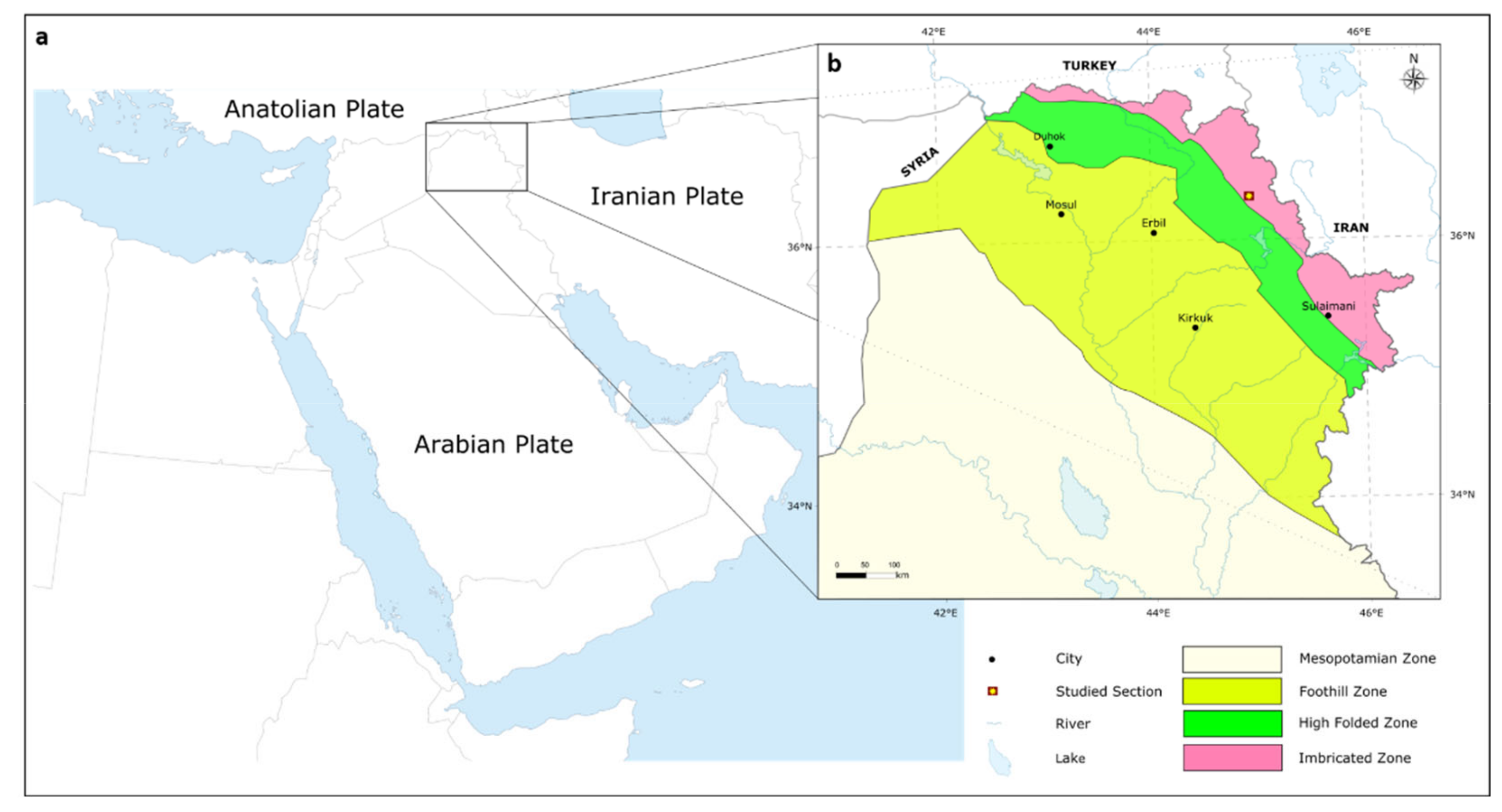
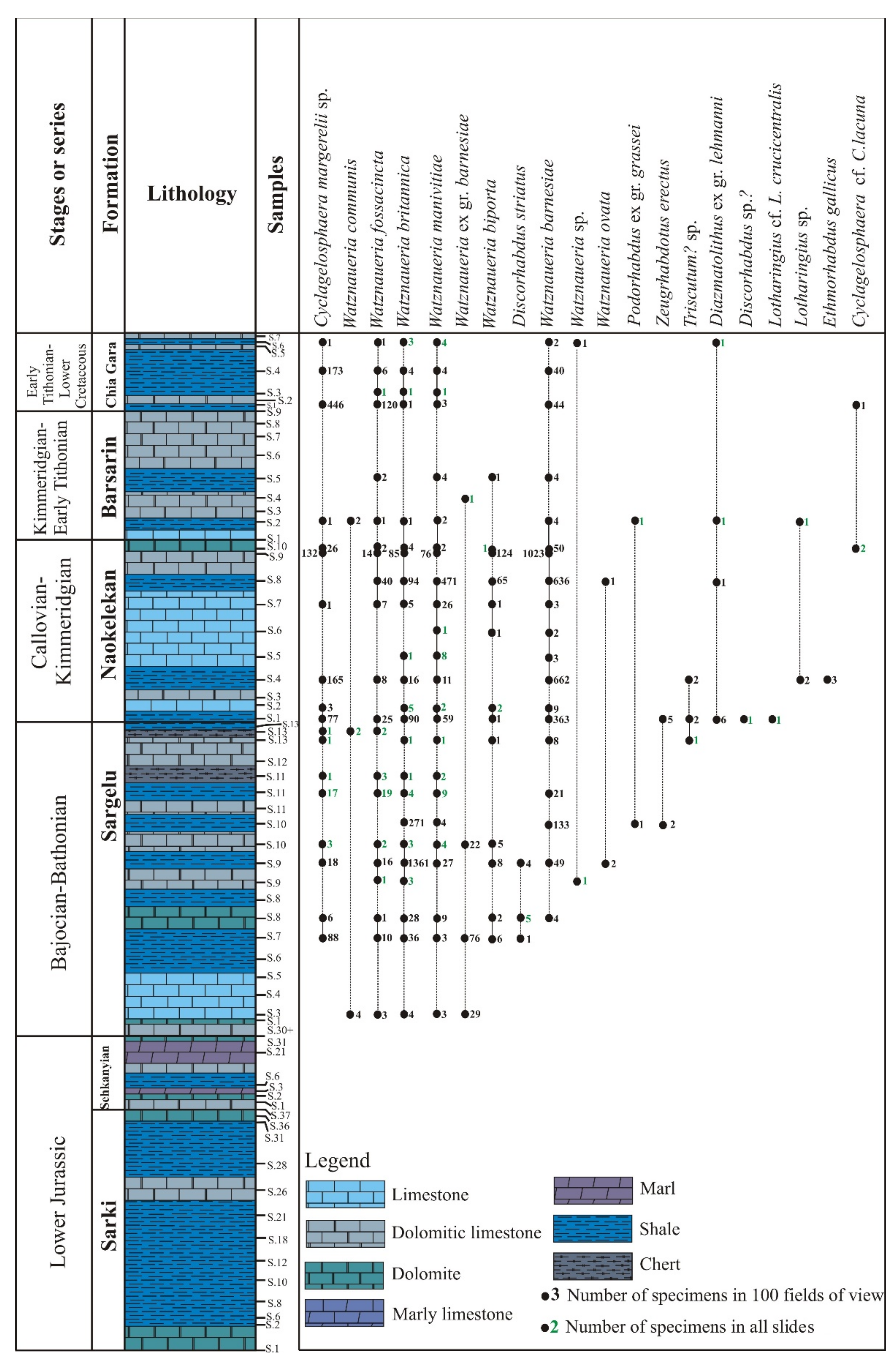
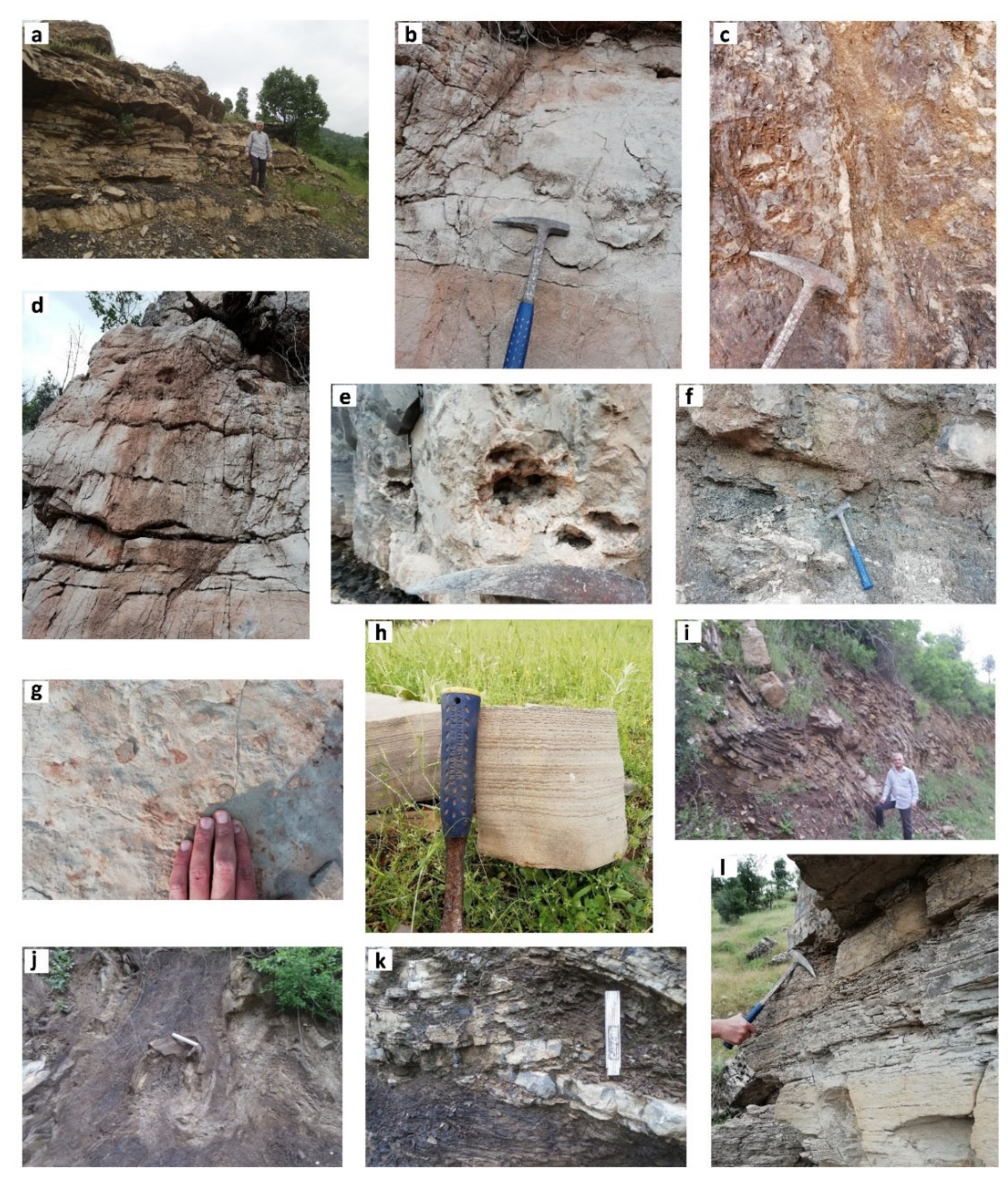
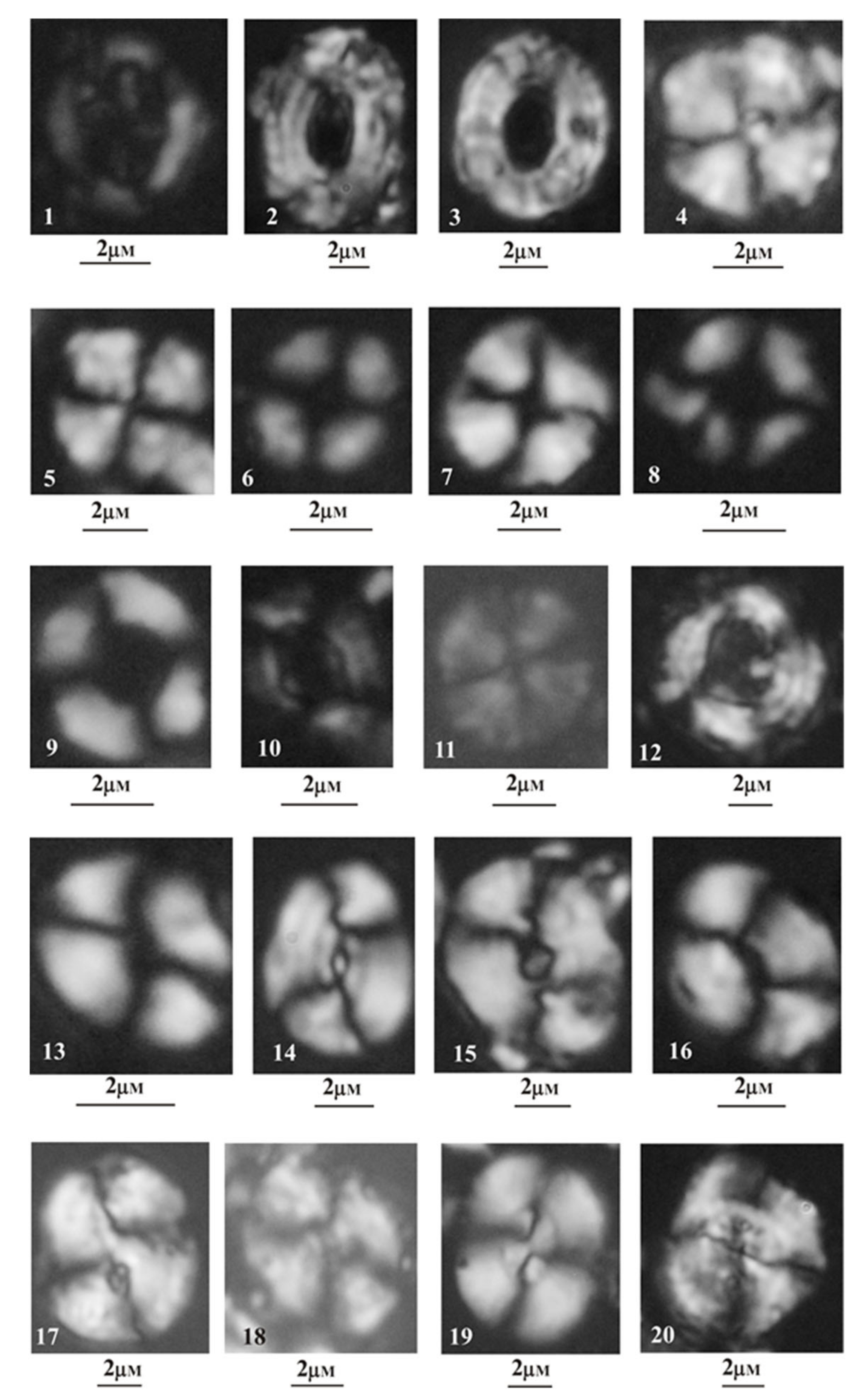
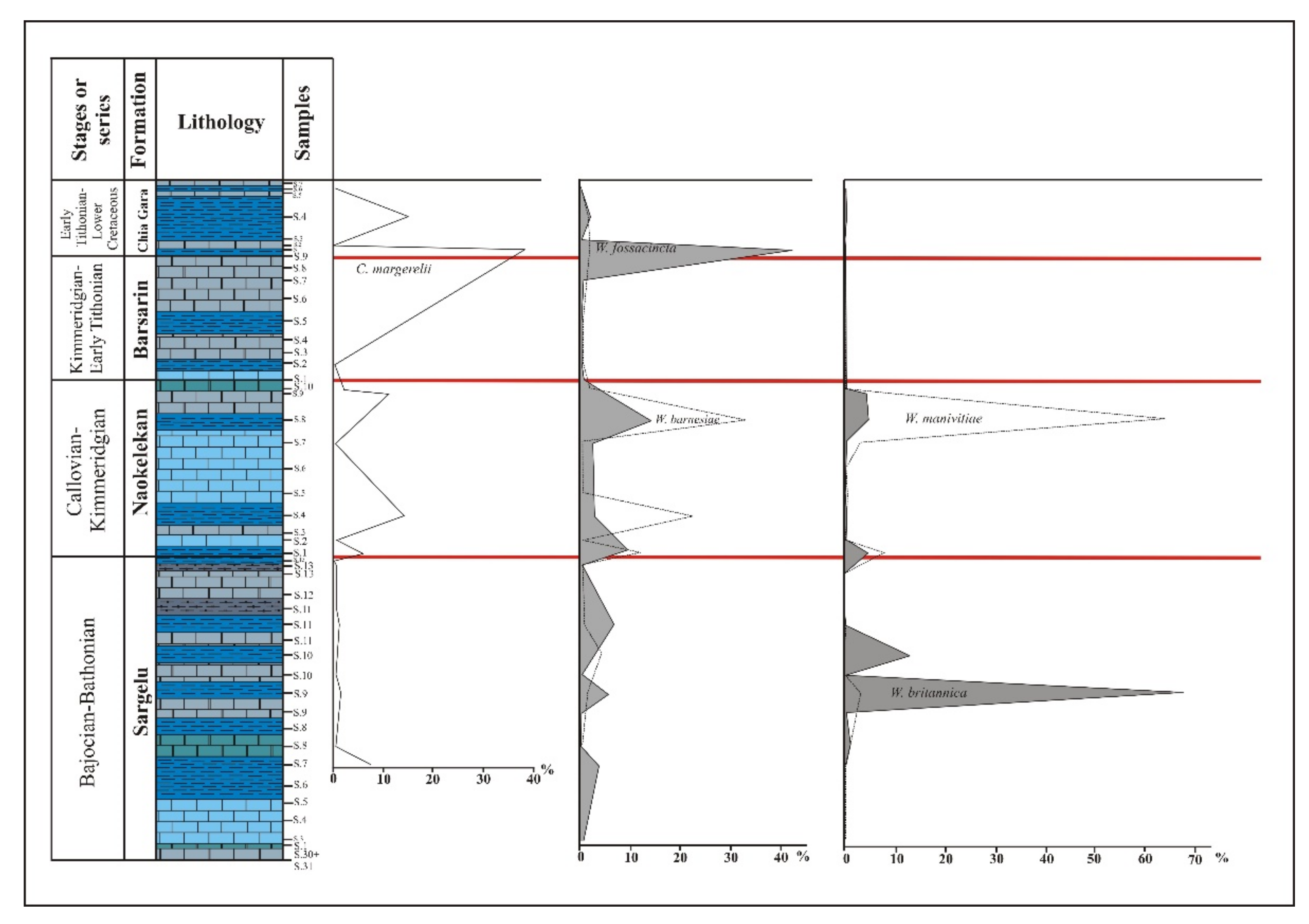
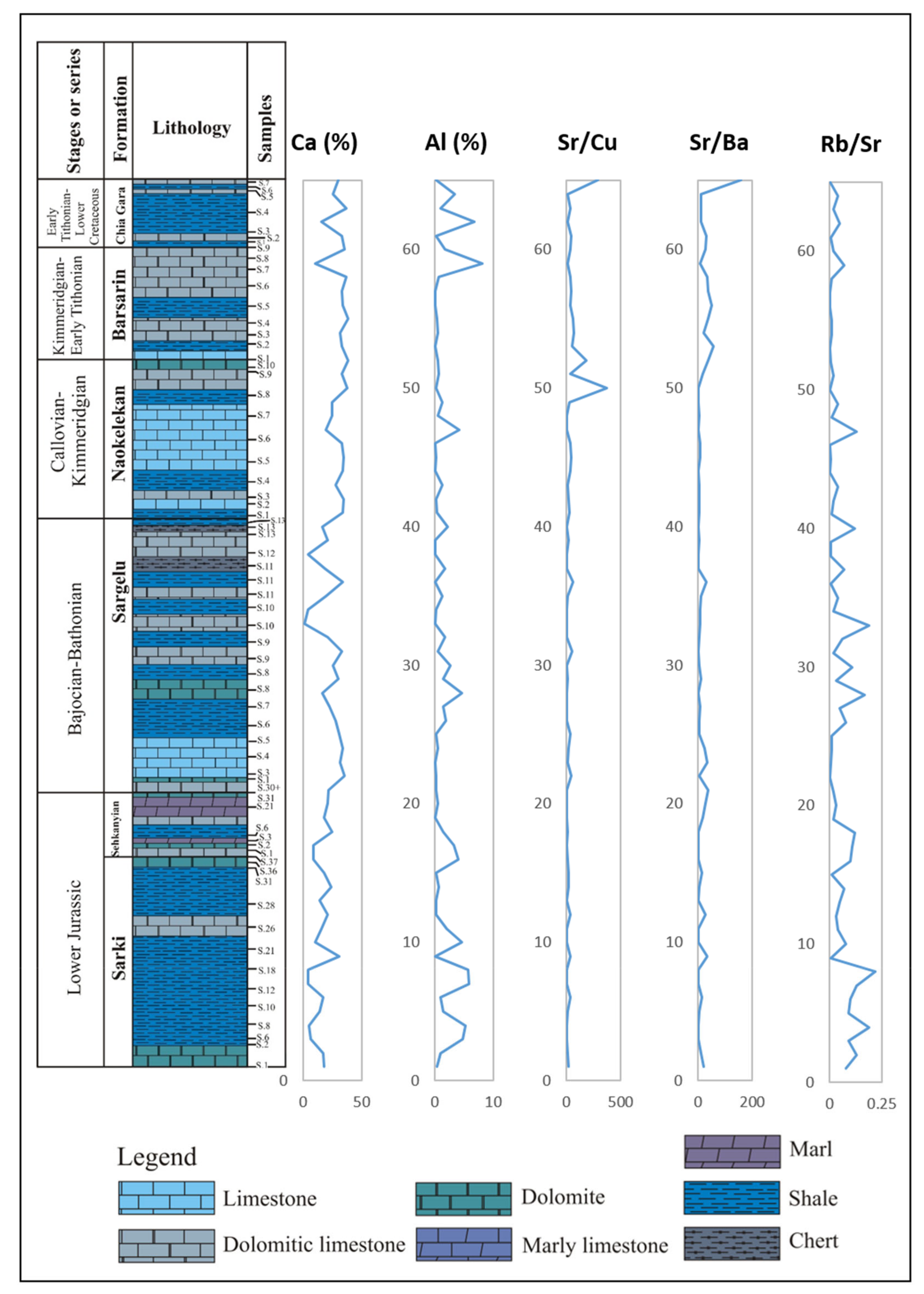

| Formation | Sample No. | Bed Thickness (m) |
|---|---|---|
| Sarki | S 1 | 0.60 |
| Sarki | S 2 | 0.20 |
| Sarki | S 6 | 0.25 |
| Sarki | S 8 | 0.15 |
| Sarki | S 10 | 0.25 |
| Sarki | S 12 | 0.20 |
| Sarki | S 18 | 0.10 |
| Sarki | S 21 | 0.30 |
| Sarki | p.c. 1 | 30.00 |
| Sarki | S 26 | 5.00 |
| Sarki | S 28 | 5.00 |
| Sarki | S 31 | 7.50 |
| Sarki | S 36 | 25.00 |
| Sarki | S 37 | 4.00 |
| Sehkanyian | S 1 | 0.40 |
| Sehkanyian | S 2 | 8.00 |
| Sehkanyian | S 3 | 0.10 |
| Sehkanyian | p.c. 1 | 5.00 |
| Sehkanyian | S 6 | 0.15 |
| Sehkanyian | S 21 | 0.25 |
| Sehkanyian | S 30 | 25.00 |
| Sehkanyian | S 31 | 25.00 |
| Sargelu | S 1 | 5.00 |
| Sargelu | S 3 | 4.00 |
| Sargelu | S 4 | 4.00 |
| Sargelu | S 5 | 4.00 |
| Sargelu | S 6 | 0.10 |
| Sargelu | S 7 | 1.00 |
| Sargelu | S 8 | 1.50 |
| Sargelu | S 8 | 1.50 |
| Sargelu | S 9 | 3.00 |
| Sargelu | S 9 | 3.00 |
| Sargelu | p.c. 1 | 6.00 |
| Sargelu | S 10 | 3.00 |
| Sargelu | S 10 | 3.00 |
| Sargelu | S 11 | 3.00 |
| Sargelu | S 11 | 3.00 |
| Sargelu | S 11 | 3.00 |
| Sargelu | S 12 | 1.00 |
| Sargelu | S 13 | 2.00 |
| Sargelu | S 13 | 2.00 |
| Sargelu | S 13 | 6.00 |
| Naokelekan | S 1 | 7.00 |
| Naokelekan | S 2 | 1.00 |
| Naokelekan | S 3 | 1.80 |
| Naokelekan | S 4 | 1.80 |
| Naokelekan | S 5 | 1.80 |
| Naokelekan | S 6 | 1.80 |
| Naokelekan | S 7 | 1.80 |
| Naokelekan | S 8 | 1.50 |
| Naokelekan | S 9 | 1.50 |
| Naokelekan | S 10 | 1.00 |
| Barsarin | S 1 | 6.00 |
| Barsarin | S 2 | 6.00 |
| Barsarin | S 3 | 2.00 |
| Barsarin | S 4 | 3.00 |
| Barsarin | S 5 | 3.00 |
| Barsarin | S 6 | 3.00 |
| Barsarin | S 7 | 5.00 |
| Barsarin | S 8 | 1.50 |
| Barsarin | S 9 | 1.50 |
| Chia Gara | S 1 | 1.43 |
| Chia Gara | S 2 | 1.43 |
| Chia Gara | S 3 | 1.43 |
| Chia Gara | S 4 | 1.43 |
| Chia Gara | S 5 | 1.43 |
| Chia Gara | S 6 | 1.43 |
| Chia Gara | S 7 | 1.43 |
| Formation | Sample No. | δ18O | δ13C |
|---|---|---|---|
| Sarki | S1 | 0.13 | −0.76 |
| Sarki | S2 | −1.03 | −0.52 |
| Sarki | S6 | −0.97 | −0.80 |
| Sarki | S8 | −2.24 | −1.23 |
| Sarki | S10 | −1.50 | −1.43 |
| Sarki | S12 | −1.86 | −1.08 |
| Sarki | S18 | −2.11 | −1.49 |
| Sarki | S21 | −1.56 | −1.95 |
| Sarki | S26 | −6.99 | −3.47 |
| Sarki | S28 | −3.22 | 0.99 |
| Sarki | S31 | −1.70 | −3.66 |
| Sarki | S36 | −1.28 | −3.05 |
| Sarki | S37 | −0.65 | −2.02 |
| Sehkanyian | S1 | −10.07 | −3.27 |
| Sehkanyian | S2 | −1.23 | −5.03 |
| Sehkanyian | S3 | −4.48 | −5.46 |
| Sehkanyian | S6 | −0.29 | −0.70 |
| Sehkanyian | S21 | −7.29 | −7.38 |
| Sehkanyian | S30 | −2.67 | −0.95 |
| Sehkanyian | S31 | −3.34 | −0.89 |
| Sargelu | S1 | −3.42 | −3.02 |
| Sargelu | S3 | −4.15 | −2.68 |
| Sargelu | S4 | −5.06 | 0.03 |
| Sargelu | S5 | −4.25 | −0.03 |
| Sargelu | S6 | −4.00 | −3.30 |
| Sargelu | S7 | −4.91 | −0.99 |
| Sargelu | S8 | −2.27 | −1.76 |
| Sargelu | S8 | −3.64 | −1.21 |
| Sargelu | S9 | −2.84 | −0.49 |
| Sargelu | S9 | −5.28 | −2.84 |
| Sargelu | S10 | −3.38 | −5.82 |
| Sargelu | S10 | −4.92 | −1.94 |
| Sargelu | S11 | −6.57 | −3.34 |
| Sargelu | S11 | −4.92 | −3.34 |
| Sargelu | S11 | i.s. 1 | i.s. 1 |
| Sargelu | S12 | −4.21 | −4.14 |
| Sargelu | S13 | −5.55 | −4.00 |
| Sargelu | S13 | −3.18 | −3.64 |
| Sargelu | S13 | −3.70 | −4.44 |
| Naokelekan | S1 | −2.22 | −3.31 |
| Naokelekan | S2 | −4.64 | −5.81 |
| Naokelekan | S3 | −5.03 | −5.82 |
| Naokelekan | S4 | −4.06 | −4.26 |
| Naokelekan | S5 | −6.82 | −3.73 |
| Naokelekan | S6 | −4.26 | −3.76 |
| Naokelekan | S7 | −3.46 | −5.49 |
| Naokelekan | S8 | −3.70 | −1.61 |
| Naokelekan | S9 | −4.25 | −4.20 |
| Naokelekan | S10 | −0.99 | −6.49 |
| Barsarin | S1 | −3.54 | −9.87 |
| Barsarin | S2 | −4.01 | −9.19 |
| Barsarin | S3 | −7.77 | −9.97 |
| Barsarin | S4 | −4.65 | −11.31 |
| Barsarin | S5 | −5.24 | −9.69 |
| Barsarin | S6 | −3.94 | −10.40 |
| Barsarin | S7 | −4.24 | −10.33 |
| Barsarin | S8 | −4.25 | −10.60 |
| Barsarin | S9 | −4.12 | −9.49 |
| Chia Gara | S1 | −5.70 | −4.70 |
| Chia Gara | S2 | −5.36 | −6.04 |
| Chia Gara | S3 | −4.60 | −8.21 |
| Chia Gara | S4 | −5.39 | −4.91 |
| Chia Gara | S5 | −3.67 | −10.65 |
| Chia Gara | S6 | −4.27 | −11.18 |
| Chia Gara | S7 | −2.13 | −9.14 |
| Formation | Sample No. | Ba (ppm) | Cu (ppm) | Sr (ppm) | Rb (ppm) | Ca (%) | Al (%) | Sr/Cu | Sr/Ba | Rb/Sr |
|---|---|---|---|---|---|---|---|---|---|---|
| Sarki | S1 | 4 | 4.3 | 87 | 6.8 | 17.74 | 0.36 | 20.23 | 21.75 | 0.08 |
| Sarki | S2 | 7 | 6.2 | 77 | 10.2 | 17.01 | 0.94 | 12.42 | 11 | 0.13 |
| Sarki | S6 | 103 | 18.8 | 102 | 10.1 | 6.21 | 4.83 | 5.43 | 0.99 | 0.09 |
| Sarki | S8 | 122 | 24 | 96 | 18.4 | 4.91 | 5.27 | 4.00 | 0.79 | 0.19 |
| Sarki | S10 | 30 | 9.4 | 105 | 9.3 | 14.35 | 1.49 | 11.17 | 3.50 | 0.09 |
| Sarki | S12 | 8 | 3.2 | 113 | 11.3 | 17.06 | 0.95 | 35.31 | 14.13 | 0.1 |
| Sarki | S18 | 133 | 22.4 | 100 | 13.3 | 4.4 | 5.93 | 4.46 | 0.75 | 0.13 |
| Sarki | S21 | 102 | 49.8 | 53 | 11.6 | 4.32 | 5.77 | 1.06 | 0.52 | 0.22 |
| Sarki | S26 | 6.0 | 5.19 | 203.1 | 1.0 | 30.96 | 0.08 | 39.13 | 33.85 | 0.005 |
| Sarki | S28 | 88 | 17.2 | 116 | 8.9 | 10.51 | 4.64 | 6.74 | 1.32 | 0.08 |
| Sarki | S31 | 115 | 56.6 | 285 | 12.8 | 15.32 | 2.02 | 5.04 | 2.48 | 0.04 |
| Sarki | S36 | 3 | 2.2 | 79 | 2.5 | 21.26 | 0.21 | 35.91 | 26.33 | 0.03 |
| Sarki | S37 | 24.9 | 12.28 | 61.1 | 3.3 | 14.49 | 0.22 | 4.98 | 2.45 | 0.05 |
| Sehkanyian | S1 | 23 | 5.2 | 111 | 7.7 | 24.32 | 0.66 | 21.35 | 4.83 | 0.07 |
| Sehkanyian | S2 | 7.2 | 4.93 | 108.3 | 0.9 | 17.69 | 0.25 | 21.97 | 15.04 | 0.008 |
| Sehkanyian | S3 | 108 | 7.5 | 62 | 6.2 | 8.85 | 4.03 | 8.27 | 0.57 | 0.1 |
| Sehkanyian | S6 | 74 | 13.2 | 82 | 9.1 | 8.87 | 3.35 | 6.21 | 1.11 | 0.11 |
| Sehkanyian | S21 | 31 | 10.2 | 92 | 10.7 | 24.46 | 1.52 | 9.02 | 2.97 | 0.12 |
| Sehkanyian | S30 | 6.2 | 14.92 | 101.5 | 2.0 | 17.60 | 0.15 | 6.80 | 16.37 | 0.02 |
| Sehkanyian | S31 | 5 | 17.6 | 137 | 4.1 | 21.18 | 0.54 | 7.78 | 27.40 | 0.03 |
| Sargelu | S1 | 3 | 18 | 112 | 1.7 | 21.86 | 0.29 | 6.22 | 37.33 | 0.02 |
| Sargelu | S3 | 67 | 8.7 | 416 | 1.3 | 35.11 | 0.22 | 47.82 | 6.21 | 0.003 |
| Sargelu | S4 | 5.0 | 10.39 | 164.4 | 0.9 | 31.57 | 0.11 | 15.82 | 32.88 | 0.005 |
| Sargelu | S5 | 9 | 9.4 | 223 | 2.5 | 33.75 | 0.47 | 23.72 | 24.78 | 0.01 |
| Sargelu | S6 | 65 | 10 | 367 | 2.9 | 31.19 | 0.23 | 36.70 | 5.65 | 0.008 |
| Sargelu | S7 | 44 | 77.8 | 260 | 20.6 | 27.77 | 1.94 | 3.34 | 5.91 | 0.08 |
| Sargelu | S8 | 23 | 50.7 | 194 | 8.9 | 22.17 | 1.38 | 3.83 | 8.43 | 0.05 |
| Sargelu | S8 | 159 | 63.5 | 302 | 51.8 | 16.63 | 4.71 | 4.76 | 1.90 | 0.17 |
| Sargelu | S9 | 24 | 27.4 | 286 | 9.5 | 30.35 | 1.44 | 10.44 | 11.92 | 0.03 |
| Sargelu | S9 | 46 | 59.7 | 194 | 21.5 | 25.38 | 2.69 | 3.25 | 4.22 | 0.11 |
| Sargelu | S10 | 586 | 5.8 | 317 | 5.2 | 32.97 | 0.55 | 54.66 | 0.54 | 0.02 |
| Sargelu | S10 | 68 | 87 | 330 | 18.6 | 21.34 | 1.68 | 3.79 | 4.85 | 0.06 |
| Sargelu | S11 | 7 | 14.3 | 46 | 8.7 | 1.55 | 0.15 | 3.22 | 6.57 | 0.19 |
| Sargelu | S11 | 12 | 16 | 86 | 2 | 3.92 | 0.2 | 5.38 | 7.17 | 0.02 |
| Sargelu | S11 | 38 | 54.6 | 445 | 16.5 | 19.66 | 1.37 | 8.15 | 11.71 | 0.04 |
| Sargelu | S12 | 8 | 3.7 | 242 | 1.1 | 33.91 | 0.11 | 65.41 | 30.25 | 0.005 |
| Sargelu | S13 | 139 | 41.5 | 293 | 21.1 | 18.79 | 1.68 | 7.06 | 2.11 | 0.07 |
| Sargelu | S13 | 41.1 | 16.06 | 73.1 | 0.4 | 4.40 | 0.03 | 4.55 | 1.78 | 0.005 |
| Sargelu | S13 | 77.5 | 14.34 | 256.9 | 1.6 | 21.23 | 0.12 | 17.91 | 3.31 | 0.006 |
| Naokelekan | S1 | 140 | 56.5 | 251 | 30.7 | 16.78 | 2.2 | 4.44 | 1.79 | 0.12 |
| Naokelekan | S2 | 89 | 16.1 | 399 | 5.9 | 34.05 | 0.42 | 24.78 | 4.48 | 0.01 |
| Naokelekan | S3 | 23 | 7.2 | 145 | 2.7 | 34.78 | 0.22 | 20.14 | 6.30 | 0.02 |
| Naokelekan | S4 | 124 | 44.3 | 504 | 18.1 | 27.75 | 1.29 | 11.38 | 4.06 | 0.04 |
| Naokelekan | S5 | 128.2 | 6.52 | 265.6 | 0.5 | 33.98 | 0.04 | 40.74 | 2.07 | 0.002 |
| Naokelekan | S6 | 57 | 8.8 | 416 | 2.4 | 34.5 | 0.19 | 47.27 | 7.30 | 0.006 |
| Naokelekan | S7 | 18.4 | 4.51 | 174.4 | 0.5 | 32.80 | 0.07 | 38.67 | 9.48 | 0.003 |
| Naokelekan | S8 | 268 | 61.4 | 333 | 42.5 | 19.51 | 4.18 | 5.42 | 1.24 | 0.13 |
| Naokelekan | S9 | 96.6 | 40.01 | 317.2 | 4.4 | 24.82 | 0.51 | 7.93 | 3.28 | 0.01 |
| Naokelekan | S10 | 287 | 11.7 | 372 | 14.1 | 25.13 | 1.28 | 31.79 | 1.30 | 0.04 |
| Barsarin | S1 | 649 | 1.2 | 446 | 1.1 | 38.07 | 0.16 | 371.67 | 0.69 | 0.002 |
| Barsarin | S2 | 22 | 9.6 | 364 | 7.2 | 33.39 | 0.71 | 37.92 | 16.55 | 0.02 |
| Barsarin | S3 | 27 | 5.5 | 1007 | 4.3 | 38.57 | 0.51 | 183.09 | 37.30 | 0.004 |
| Barsarin | S4 | 4.2 | 4.23 | 241.4 | 0.5 | 33.16 | 0.05 | 57.07 | 57.48 | 0.002 |
| Barsarin | S5 | 19 | 5.6 | 377 | 5.1 | 31.34 | 0.59 | 67.32 | 19.84 | 0.01 |
| Barsarin | S6 | 7 | 4.2 | 269 | 2.5 | 38.66 | 0.46 | 64.05 | 38.43 | 0.009 |
| Barsarin | S7 | 3.3 | 4.07 | 163.3 | 0.4 | 33.91 | 0.04 | 40.12 | 49.48 | 0.002 |
| Barsarin | S8 | 4.0 | 3.02 | 147.3 | 0.3 | 33.50 | 0.04 | 48.77 | 36.83 | 0.002 |
| Barsarin | S9 | 12 | 11.2 | 391 | 4.4 | 36.91 | 0.63 | 34.91 | 32.58 | 0.01 |
| Chia Gara | S1 | 102 | 75.9 | 764 | 52.9 | 10.04 | 8.12 | 10.07 | 7.49 | 0.07 |
| Chia Gara | S2 | 27 | 21.9 | 761 | 11.6 | 35.78 | 1.77 | 34.75 | 28.19 | 0.02 |
| Chia Gara | S3 | 10 | 7.2 | 314 | 1.4 | 33.22 | 0.28 | 43.61 | 31.40 | 0.004 |
| Chia Gara | S4 | 112 | 92.1 | 1088 | 51.7 | 15.67 | 6.79 | 11.81 | 9.71 | 0.05 |
| Chia Gara | S5 | 25 | 7.8 | 274 | 5.5 | 36.73 | 0.94 | 35.13 | 10.96 | 0.02 |
| Chia Gara | S6 | 54 | 58.3 | 549 | 22 | 25.61 | 3.39 | 9.42 | 10.17 | 0.04 |
| Chia Gara | S7 | 2 | 1.1 | 321 | 1 | 30.06 | 0.19 | 291.82 | 160.50 | 0.003 |
Publisher’s Note: MDPI stays neutral with regard to jurisdictional claims in published maps and institutional affiliations. |
© 2022 by the authors. Licensee MDPI, Basel, Switzerland. This article is an open access article distributed under the terms and conditions of the Creative Commons Attribution (CC BY) license (https://creativecommons.org/licenses/by/4.0/).
Share and Cite
Omar, N.; McCann, T.; Al-Juboury, A.I.; Ustinova, M.A.; Sharezwri, A.O. Early Jurassic–Early Cretaceous Calcareous Nannofossil Biostratigraphy and Geochemistry, Northeastern Iraqi Kurdistan: Implications for Paleoclimate and Paleoecological Conditions. Geosciences 2022, 12, 94. https://doi.org/10.3390/geosciences12020094
Omar N, McCann T, Al-Juboury AI, Ustinova MA, Sharezwri AO. Early Jurassic–Early Cretaceous Calcareous Nannofossil Biostratigraphy and Geochemistry, Northeastern Iraqi Kurdistan: Implications for Paleoclimate and Paleoecological Conditions. Geosciences. 2022; 12(2):94. https://doi.org/10.3390/geosciences12020094
Chicago/Turabian StyleOmar, Nagham, Tom McCann, Ali I. Al-Juboury, Maria A. Ustinova, and Arkan O. Sharezwri. 2022. "Early Jurassic–Early Cretaceous Calcareous Nannofossil Biostratigraphy and Geochemistry, Northeastern Iraqi Kurdistan: Implications for Paleoclimate and Paleoecological Conditions" Geosciences 12, no. 2: 94. https://doi.org/10.3390/geosciences12020094






